A trip to Jordan
Notes I wrote during my trip to Jordan
Day 1 - Saturday: arrival and initial exploration
We arrived into Jordan early in the morning, with our flight delayed by an hour or so. Once making our way through the terminal and paying for our visa (40 JOD) we met our friendly driver Omar, who drove us to our hotel. On the journey he gave us some facts about Jordan (11 million population, 5 million in Amman, for example) and taught us a few useful phrases:
- Shukran - thank you
- la - no
- na'am - yes
We checked into the Landmark hotel and went straight to bed to catch up on some much needed sleep!
We woke up just in time for the hotel breakfast the next morning. The chef met us and talked us through the different foods on offer, and even helped us prepare some of the local breakfast foods. The highlight being the fava bean mix, served with tahini, tomatoes, coriander and plenty of olive oil. Washed down with some fruit juice, coffee and a few falafels to get us ready for our first day of exploring.
Fun fact - the hotel once held the Guinness World Record for the largest falafel at 75kg (been beaten recently by another hotel in Jordan near the dead sea).
After breakfast we asked the hotel to book us a taxi to the Jordan Museum. I quickly discovered I’d been a bit ripped off here - Uber showed the journey as 1.500 JOD and I got quoted 35 JOD by the driver. I haggled down to 15 JOD and learned a lesson along the way - be prepared to haggle as a tourist. Been a while where I’ve been to a country where it’s acceptable and accepted.
The Jordan Museum was really interesting - a sort of linear history of life in Jordan, starting from the prehistoric era (20,000–30,000 BC). There is such a rich history in this area and there were plenty of artifacts from ancient times. The Dead Sea Scrolls found in a cave were particularly interesting, along with the rolled metal treasure maps.
After the museum we walked to Rainbow Street, a popular spot for tourists. We stopped at a cafe here for a cup of tea and watched the world go by for a while.
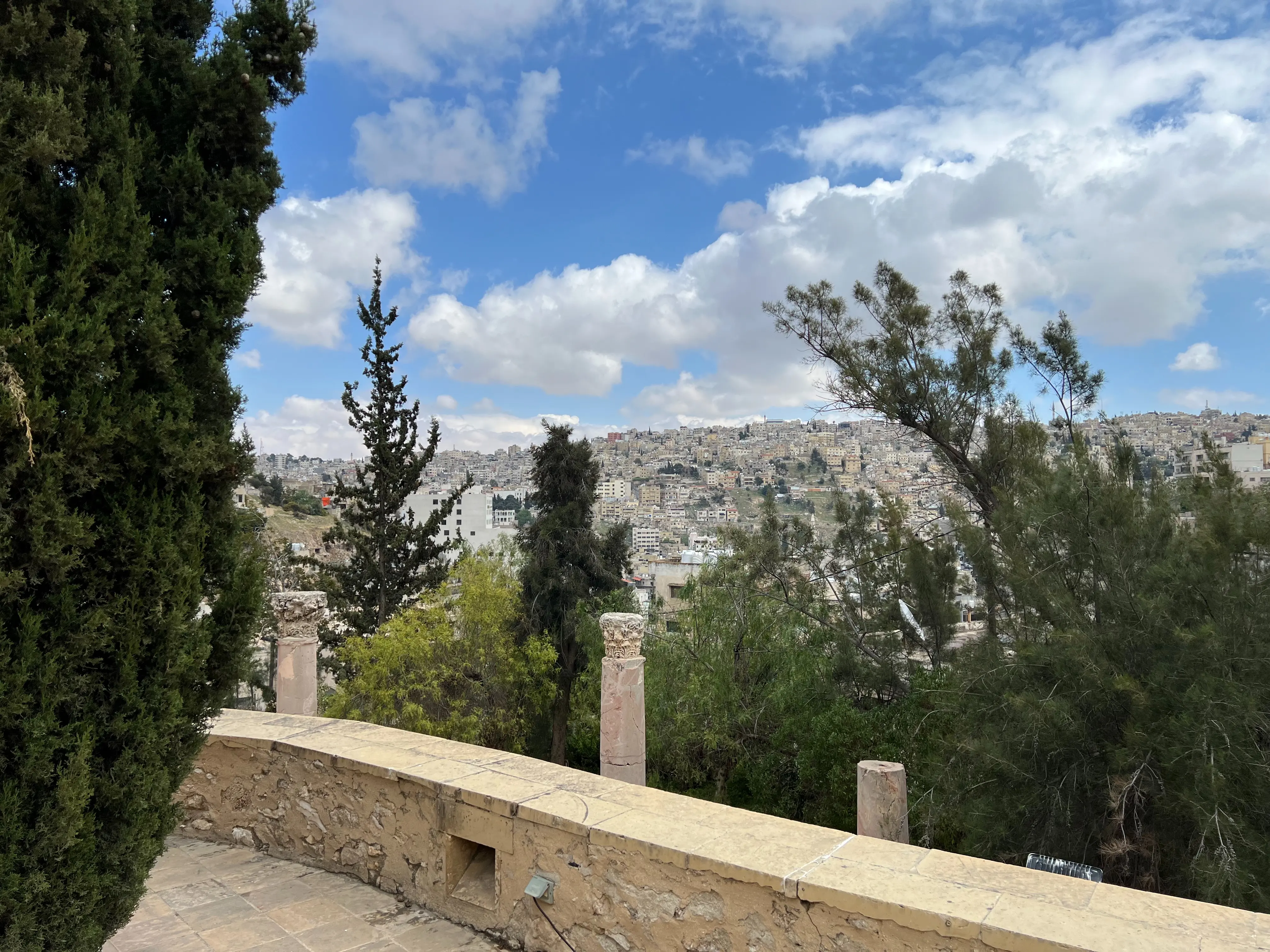
Next was a trip down into the bazaar in the “downtown” area. Compared to the quiet hilltop cafe the energy levels had certainly changed… people everywhere and lots of shops selling a bit of everything. Got asked to try free perfume samples, although said no to those as wasn’t sure if yes to a sample meant yes to a bottle! We got two small bowls that you might put some dip in, or maybe cigarette butts depending on your company. These were originally offered to us for the price of 75 JOD, but we left having paid only 5 JOD.
Walking down the street you do get a lot of attention as a tourist, people want you to come into their stores and see what they have, but it’s always done with a smile and does not feel as forceful as it can in some other countries. A few times after politely declining, I was asked where I was from and had a quick chat before being told “Welcome to Jordan" and to have a nice day. The people here really are friendly!
Next we walked up to Paris Square, via a small art exhibition. More stairs but worth the walk - we got to the square and went to a nearby restaurant called Jordan Heritage for a late lunch. They aim to keep authentic food alive, and were treated to a delicious meal of Tabouleh, Aubergine, Mansaf and flat breads. We tried a beer from the relatively newly opened microbrewery Carakale, also delicious. Looking back on this meal, it was fairly expensive compared to what we'd spend later on - definitely more of a tourist spot but it was a lovely setting.
Full of local food, it was time to head back to the hotel after a busy first day with a slight lack of sleep. This time we got an Uber, which cost only 1.5 JOD + 1 JOD tip. Lesson learned!
Day 2 - Sunday: more exploration and meeting the tour
We woke up after a well needed sleep and had another selection of breakfast food from the hotel. Then we took a taxi to Jungle Fever Cafe, which sits above the fine art museum. I had a hibiscus lemonade and Hannah had a tea.
After this we walked to the King Abdullah I Mosque where we went to look at the impressive dome from the inside. There was a huge gift shop - Hannah got a ring and I got a cotton Kaffiyeh to wear once we reached the desert. The shop here is pretty expensive and definitely for tourists only - I'd recommend buying things from downtown instead of here now that I've seen the comparative prices!
From the mosque we walked to Rumi for another coffee stop - I had an Arabic coffee and Hannah had a latte. From here we walked down into the bustling downtown area, which was much quieter compared to the business of the Saturday (the weekend days are Friday and Saturday here vs Saturday and Sunday at home). I grabbed a basic wallet to use whilst I was here as my Ridge wallet isn’t great for holding cash, which we were mostly using here. Card is accepted pretty much everywhere though, which is very useful.

We took another taxi to Shawerma Reem - a small store that sells a shawarma wrap for 1 JOD. They’re fairly small, definitely one per person needed, but really tasty. A great snack to have on the go - a lot of locals / taxi drivers were stopping here for a quick bite.
Then we headed back to the hotel for a rest, as we were still feeling pretty tired and we did a fair amount of walking the hills of Amman again. We met up with our tour guide Ayman and the rest of our tour group: Stefan, Clive, Rosemary, Gordon and Vicki. We went out to a local restaurant where Ayman ordered us a spread of delicious food, and we left feeling excited for the rest of the tour and full of a very well priced (15 JOD pp) meal.
Day 3 - Monday: first day of the tour to Jerash
Today was the first day of our G Adventures tour. We got up early for breakfast and left the hotel at 7:15 for Jerash, an ancient city. We were some of the first people to arrive to were able to explore without any crowds for a while, and took some great photos.
The site is absolutely massive, and has been restored enough to give you an idea of the scale and beauty of the old city. Originally built by the Greeks, much of it was destroyed and rebuilt by the Romans, and so on. Huge gates, temples, amphitheaters and columns are spread around the site. After exploring we had a quick coffee and freshly squeezed orange juice before heading back onto the bus.
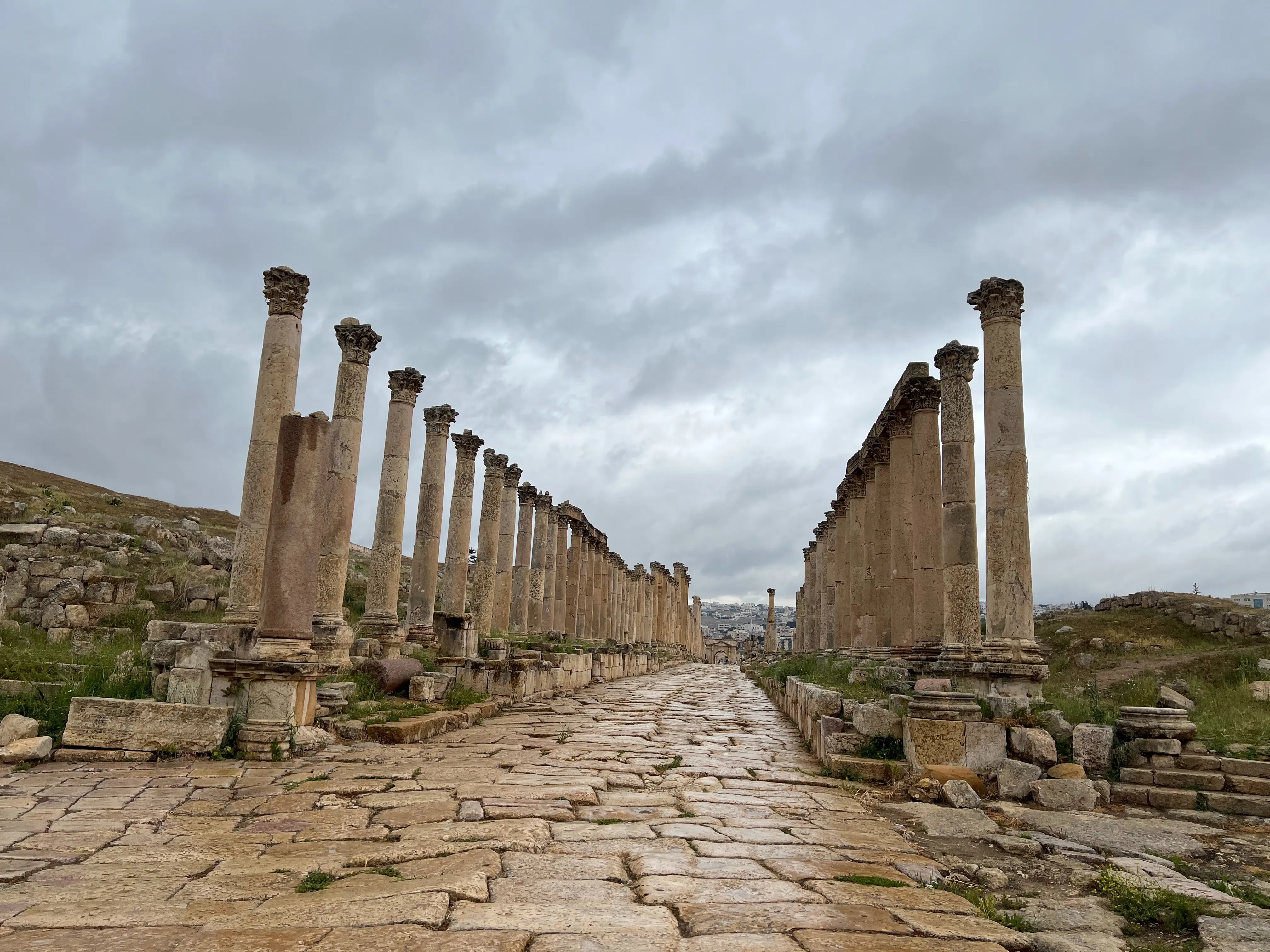
Our next stop was a small women-run cafe called Beit Khayrat Souf, where we were taught how to cook Maqluba - a dish made with chicken, rice and vegetables which are served in a pot which is eventually flipped over to present the dish (the name Maquluba means "upside-down" in Arabic). Once again the food was delicious and there was far too much… we were told that no food is wasted though, and it will be eaten by somebody and not thrown away.
After lunch we were driven back towards Amman to the hilltop citadel, which existed from when Amman was known by its Roman name Philadelphia. It sits above the huge 8,000 person amphitheatre and boasts another large temple to Hercules, as well as a Byzantine church which was converted to a reception room when the area was rules by the Umayyad Caliphate.

After exploring the ruins here we headed back to the hotel, but not before stopping at Alsahel Alakhdar for a delicious portion of Knafeh: a traditional Arab dessert made with cheese and topped with spun pastry dough which has been soaked in a sweet syrup. It’s a perfect blend of sweet and savoury!
We ended up having a few drinks with the rest of the group in the top floor bar of the hotel, overlooking Amman from sunset.
Day 4 - Tuesday: Mt. Nebo and Wadi Musa
A relaxing start to the day, with our final breakfast at the Landmark hotel. With our bags packed we headed off in a new bus to Mt. Nebo.
The journey didn’t feel like we’d gone too far, let alone uphill, but suddenly we were parked near the top of a tall mountain, with a white church ahead of us. This is where Moses finished his journey at the tender age of 102 and spent the rest of his life.
On top of the hill is a Byzantine basilica which has been partly reconstructed. Inside are some incredible mosaics. There is also a small museum showing some finds around the area, and more information about the rest of the ruins around the site.

Leaving Mt Nebo, we had a quick stop at The Tree of Life - a local workshop where people create mosaics by hand. The mosaics they make are largely based off of existing ones, however there were some other designs around (such as Einstein's face). It can take weeks to create a single mosaic - due to how painstaking the work is, it’s usually only done for 2hrs each day.
Our bus was now headed towards Wadi Musa (valley of Moses, named as he is said to have touched the ground here and created a spring) which is approximately 250km south of Amman. We stopped for a falafel sandwich on the way.
When arriving at Wadi Musa you can see the rock formations of Petra in the distance - they stand out against the rest of the journey which was largely desert. The rocks almost don’t look natural, with the weathered sandstone creating soft rounded columns. We had a quick stop at Moses’ spring (one of the springs used by the Nabateans to store water) then arrived at our next hotel; The Old Village Resort.
The name sums up the feel of the hotel - it was once an old village that was renovated and is now a large hotel. It’s much quieter here compared to Amman, and the rooms are large with a lot of character.
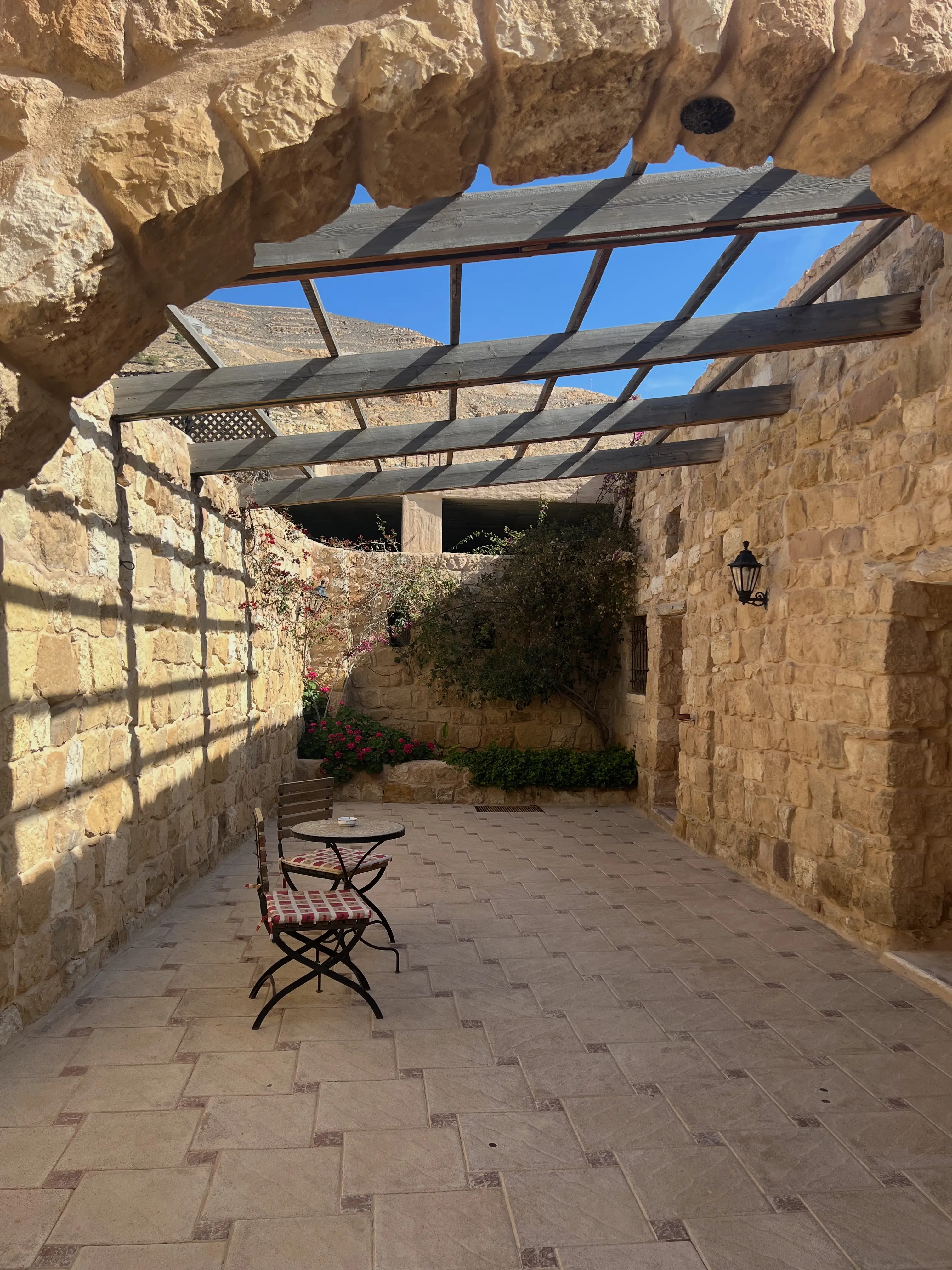
After a tasty dinner and a prep talk from Ayman on the do’s and dont’s of Petra, we headed to bed for an early night, as we’d be getting up at 5am to get to Petra early to avoid the crowds.
Day 5 - Wednesday: Petra
Another early start today, and we left the rest of the group to go via the “back door” to Petra. We got dropped off at Little Petra, another gap in the sandstone rocks that was inhabited for some time, featuring a couple of the classic carved tombs in the red rocks. We spent around 30 mins here with nobody else around (it was around 6am) and then started walking along the trail towards the main Petra site.
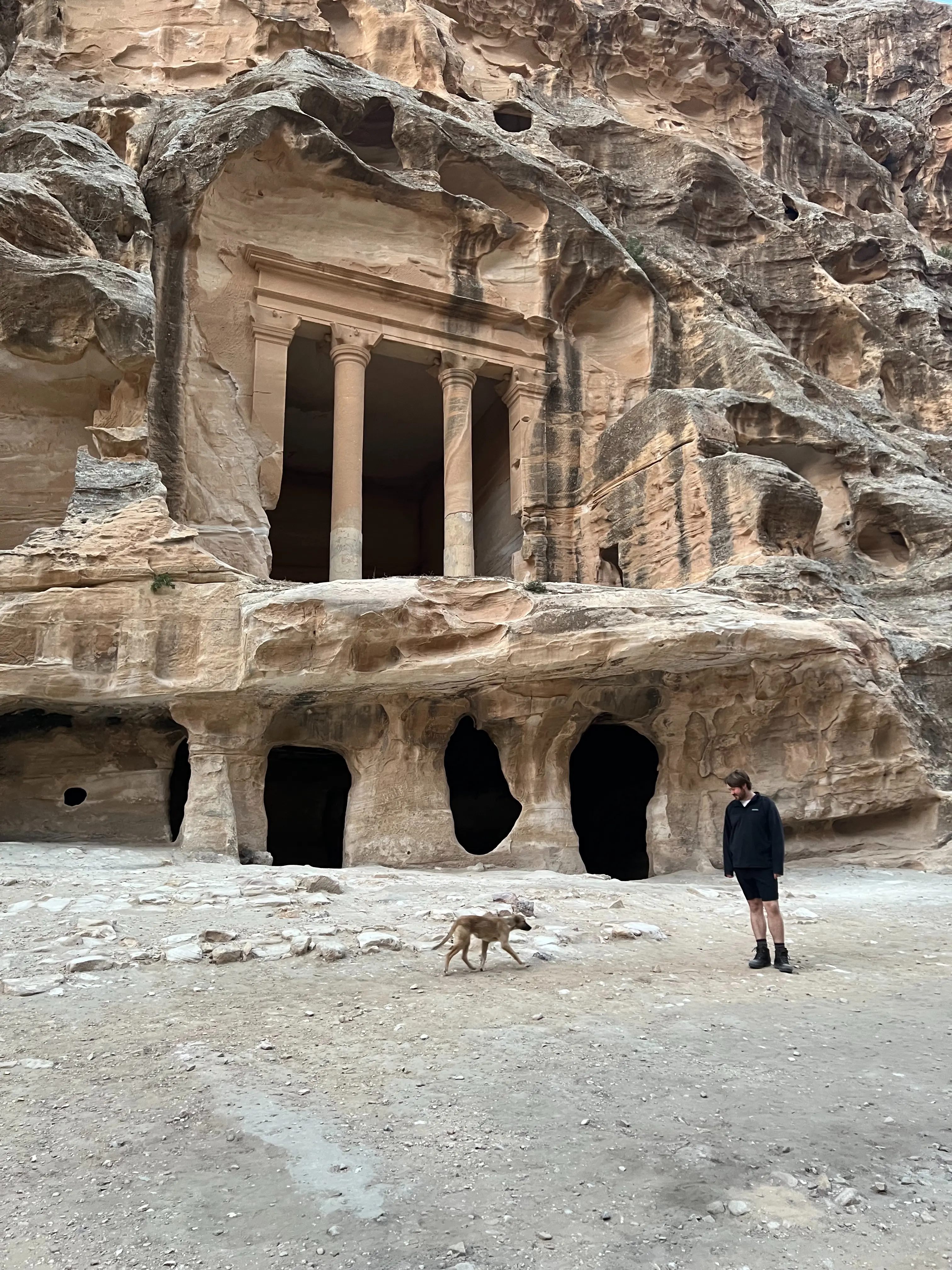
The walk takes you through a quiet stretch of the desert, with your final destination being the Monastery. Locals offered to drive us the majority of the way, however we decided to walk it and enjoy the silence of the desert landscape.
After around 45 minutes of walking we reached the bottom of a set of stairs which winds through the rocks, cut into the side of the hill. These steps take you up and around the rocks, eventually giving you stunning views from the top. From here it was about another 30 minutes walk until we got our first glimpse of the Monastery.
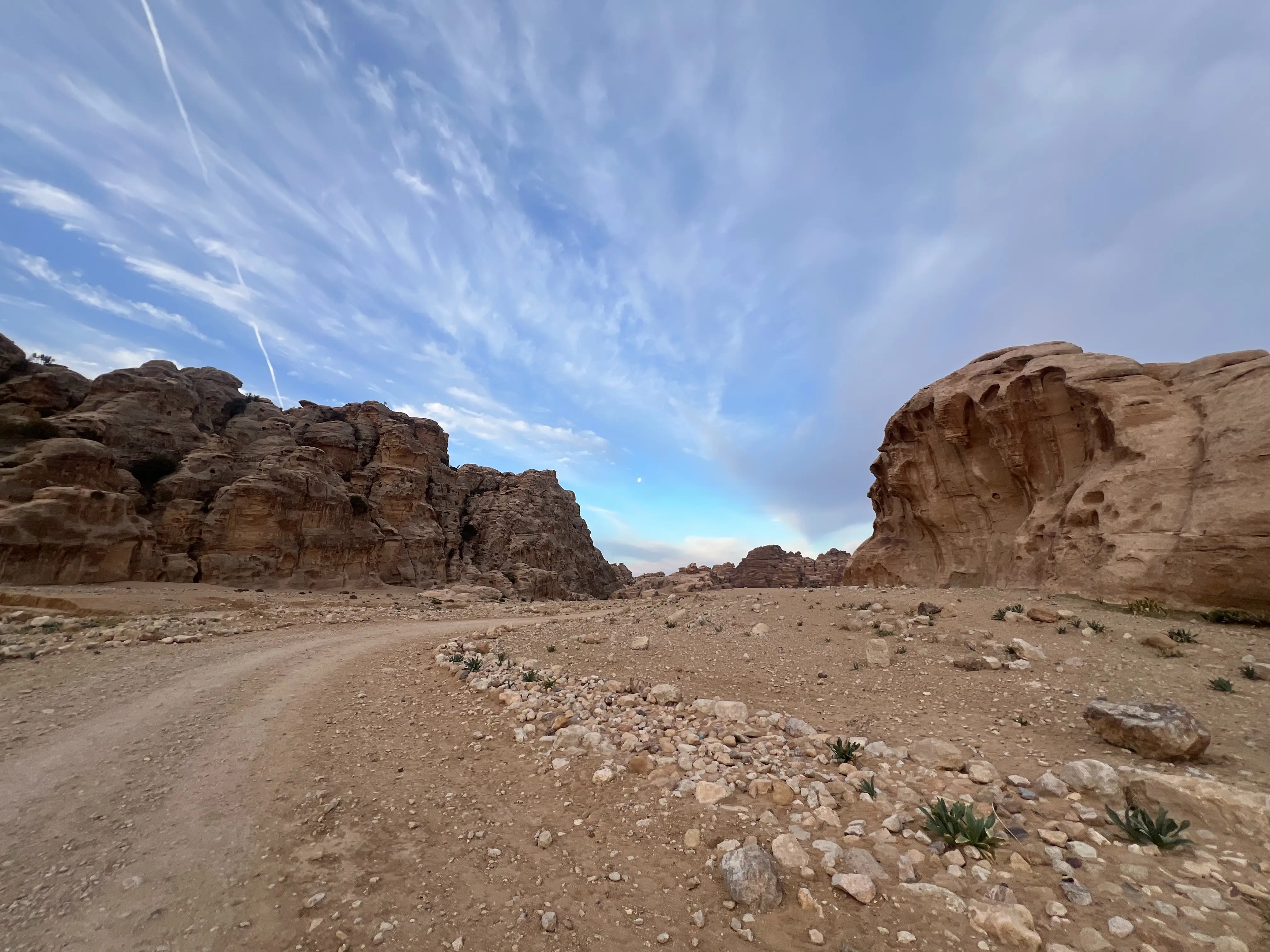
You first see the top of some of the towers, and as you continue along the path more and more comes into view. The Monastery is a huge structure, and in a similar fashion to the Treasury below, some of it is buried under sands which have built up over time.
We were almost the only people there, which made the early start worthwhile. It was a bit of a strange experience - the monumental carvings in stone, made by an ancient civilisation - sitting opposite a makeshift cafe selling cold drinks and fridge magnets. Despite the juxtaposition, it was still an awesome sight. Seeing it in person really helps put the pictures in perspective, along with the scale of these tombs.
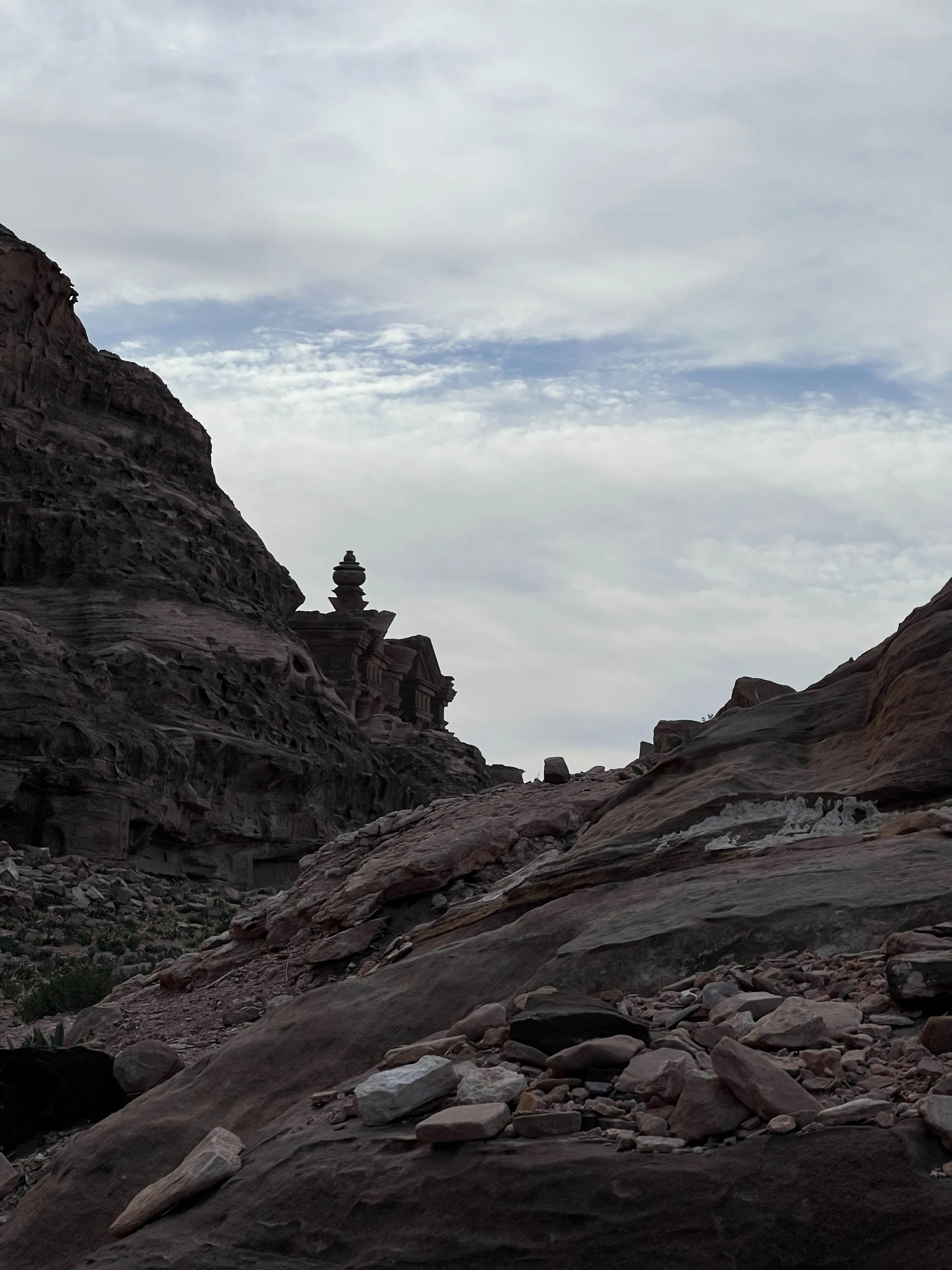
From here we started the walk down the ~900 steps back down towards the main site. Along this path there are even more shops, selling tourist friendly bits and bobs - none of which is actually locally made despite what you may be told. The people running these stands once occupied the Petra site but were moved when it became a UNESCO world heritage site; the deal was that they could come inside and run shops in exchange for their removal.
We met up with the rest of the group on our way down who were climbing up to the Monastery. They’d entered Petra through the “front” through a gorge called Al Siq. Their welcome had been the iconic Treasury building, which slowly reveals itself as you walk down a long gorge full of aquifers. They’d also managed to see the Treasury without any crowds (in fact they were the first people there).
We stopped for a quick chat with Ayman and grabbed some lunch to be eaten on-the-go and walked along the cardo maximus, taking in the Roman / Byzantine ruins along the way. This part was less well-preserved than the city of Jerash, however this was made up for with the views of huge carved temples in the background.
Next we decided to make the climb up another set of stairs, the top of which give you a panoramic view of the amphitheatre (the only one ever found that instead of being built by stone, was carved into the rock itself) and the Treasury. This would be our first glimpse of it, and it did not disappoint! There are not many safety features at the viewpoint. It’s just a ledge with a rather large drop, but also a pretty iconic view of the tombs facade. By the time we reached the Treasury there were a lot of people milling around - we’d definitely missed the quiet times of the morning.
Next we walked along the temples of the gods, taking in more of the carved rock faces and their sheer scale. This route leads you back towards the main entrance, where you can see tombs and eventually, the Treasury itself. Although it isn’t as big as the Monastery, it’s arguably more impressive due to it’s location inside the gorge, along with the amazing carvings that have been preserved due to the designs of it’s builders - a lip of stone over the top, and water-ways to redirect falling rainwater away from the intricately carved stone.
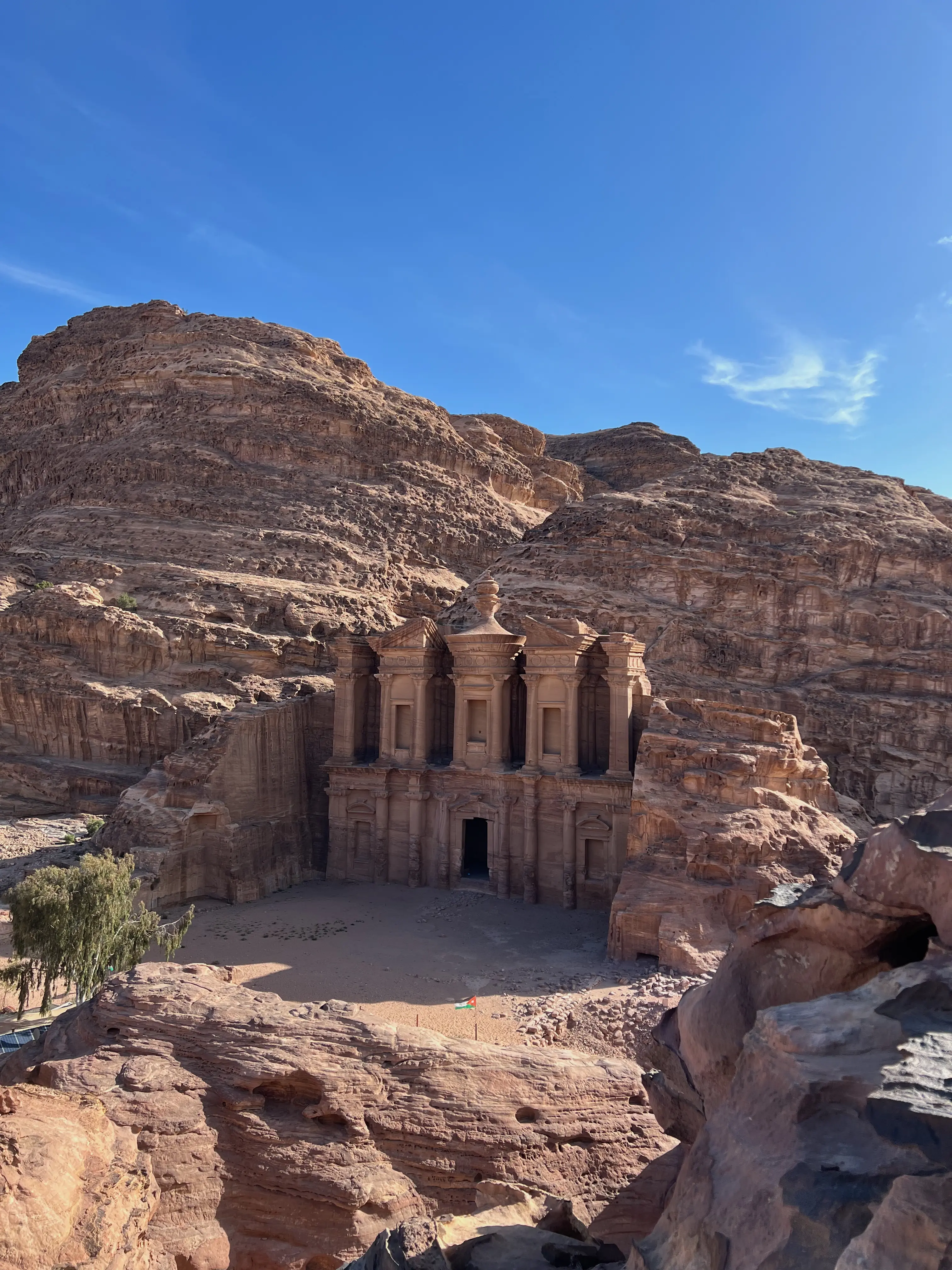
Leaving Petra we went to the museum to see some of the finds - it’s got a good selection of finds ranging from the earliest human camps (20-30,000 BC) and onwards.
Our hotel had a hot tub which was extremely useful for leg recovery - we’d done around 34,000 steps at this point, a lot of which were uphill.
After a delicious dinner of Mansaf - the Bedouin dish which is eaten at celebrations such as Weddings, we headed back to Petra for “Petra at Night”. Our tour guide managed to give us access to go first down the gorge, which had been lit up by hundreds of candles. It was a really special experience after walking up it in the busy part of the day.

At the bottom of the gorge, the Treasury was lit up with multi-coloured lights, and we sat and listened to some traditional Bedouin music from a flute and single stringed instrument called a Rababa.
Day 6 - Thursday: Wadi Rum
After a well needed lie in, we started our journey along the Kings Highway to Wadi Rum. Leaving Petra behind us, we stopped quickly at a view point to see just how well hidden and defended the ancient city was - the entrance is hard to spot despite the number of tourists heading inside.
After the Kings highway, we headed south down the Desert Highway. After a coffee stop we finally reached the main entrance to Wadi Rum. Here we had a quick stop at the visitor centre where Ayman got our passes sorted - this ares is a conservation area so you need to pay to stay there. After getting our tickets the bus continued for a little while longer, until we reached a flat area which led to sand.
This is where we switched from our bus into 4x4s. Our luggage in one, and us sat in makeshift benches in the back of another. The Rahayeb Desert Camp isn’t located too far into the desert, and it took around 10 minutes to get there. It’s nestled in between one of the many rock formations which make up the intense landscape of Wadi Rum.
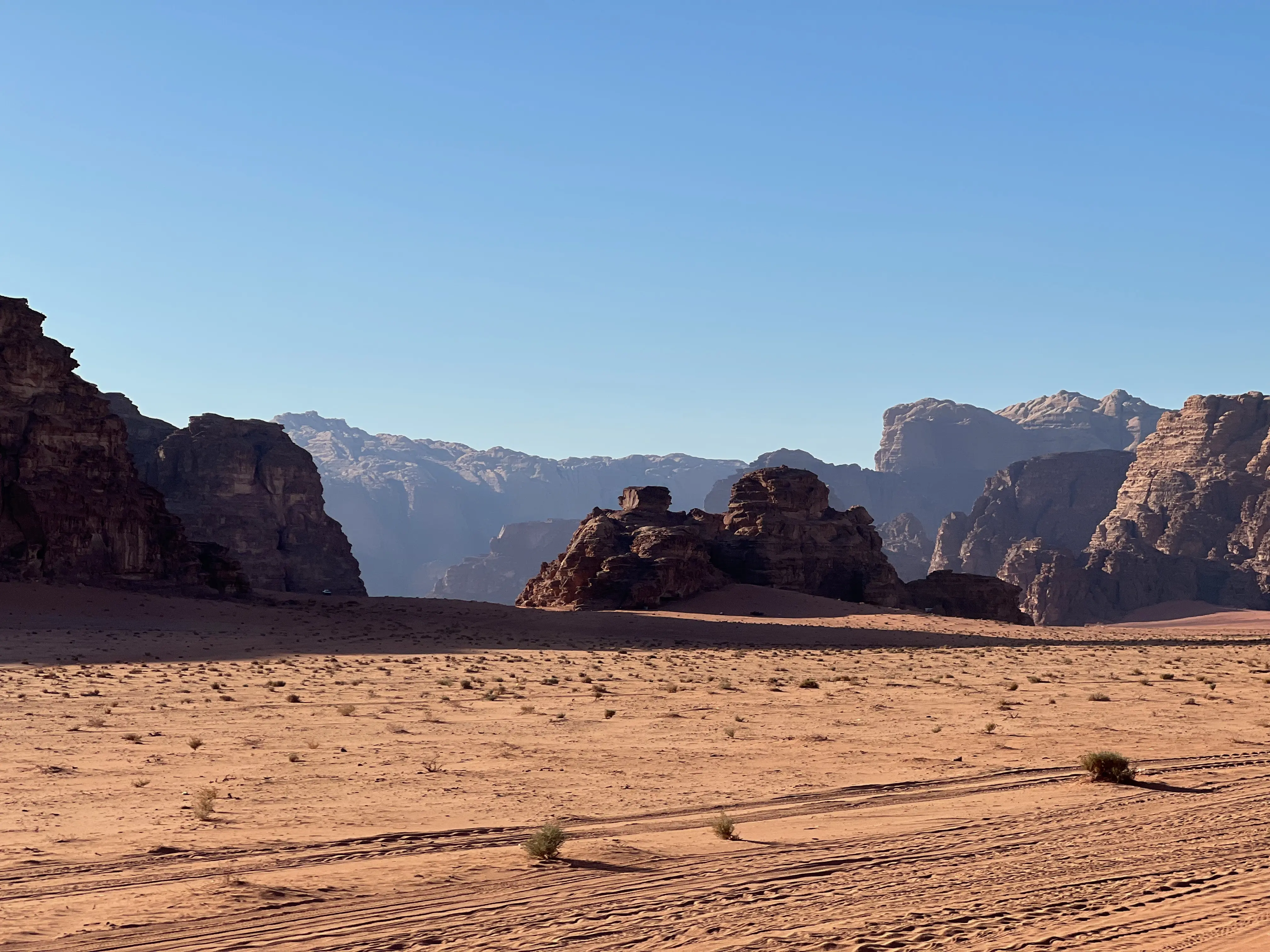
Our rooms were wrapped in the traditional Bedouin style cloths, but inside it was more of a room than a tent. It had a large bed, lighting and UK plugs, as well as a fully plumbed in bathroom - quite impressive considering its location!
After getting our stuff into the room we got back into the 4x4s and went on a trip out into the desert. The landscape was beautiful; Our guide told us that Wadi Rum means “valley of unconnected rocks” and you can see why (although the exact translation might be closer to Valley of the Moon / Sand). Scattered throughout the desert are mountains of red and yellow sandstone, all of which have been weathered over their 500 million years of existence.
The first stop on our desert tour was a canyon running into one of these mountains. On one side were carvings left by the Ottomans; they’d left inscriptions of verses from the Quran. After some more driving we saw another inscription left by the Nabateans, which was a depiction of them hunting Ibex with spears from camels and falcons. We were told that all people who entered this desert left some sort of mark.
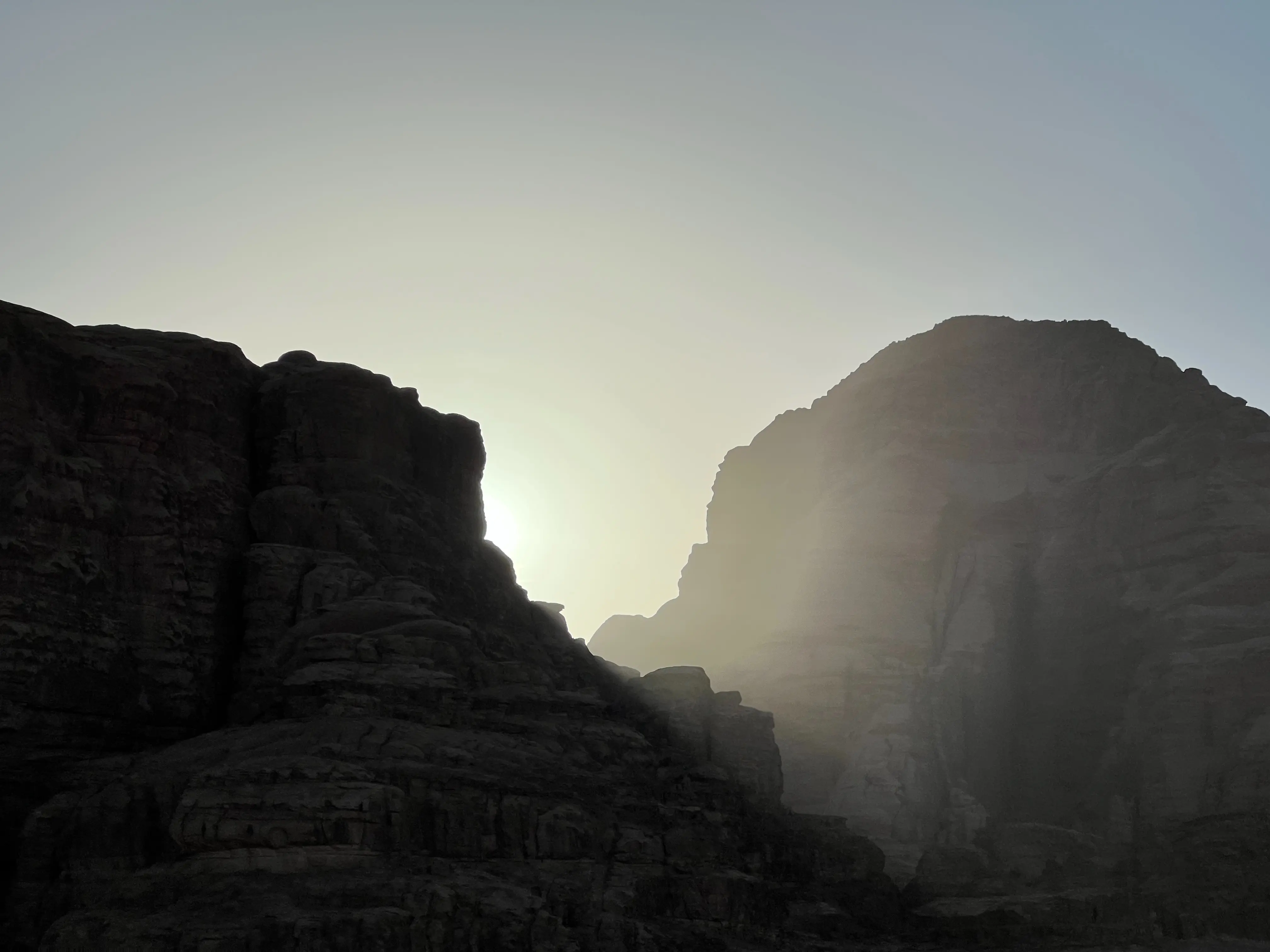
On our tour of the desert we also saw a wall which made up part of Lawrence of Arabia’s house, the place he stayed in the desert whilst writing Seven Pillars of Wisdom. At the end of the tour we found a quiet spot to sit and watch the sunset.
After getting back to camp we went to watch the unveiling of dinner, which had been cooking in pits in the ground for the past 3-4 hours. Inside the pots was rice, lamb, chicken and vegetables. We all grabbed a large plate of food and enjoyed an alcohol free beer whilst eating under the dusk sky.
After dinner we once again hopped into a 4x4 and drove off into the dark, looking for a quiet spot in to sit and look at the stars. After 15 minutes of driving through the dark we found ourselves a spot and lit a small fire and took in the views of the cosmos. Ayman made us some tea whilst we lay back and enjoyed the peace of the desert.
Day 7 - Friday: Dead Sea
After a good sleep in the desert we loaded back into the 4x4s to head back towards the main road and transferred back into the bus. We had a bit of a drive ahead of us now to the dead sea. We headed off via Aqaba, the city that sits only metres away from Israel on the coast of the Red Sea. We didn’t go into town, but it was interesting to see just how close they were.
We drove north from here along the border between Jordan and Israel, which is marked by a tall fence. Apparently the border here is strictly enforced, with only 3 crossing points which are well guarded.
We crossed a checkpoint where a customs guard briefly got onto the bus and had a quick look and a chat with our guide. The Aqaba area has some different tax rules which were brought into place to try and encourage investment into the area - but that does mean that goods taken out of the area are checked. We were told that the guard legally couldn’t come any further into the bus; tourism is so important here that they want to avoid any situation where visitors are made to be late or feel threatened.
We stopped by another of G-Aventures initiatives, this time a small community run farm made up of members of a village called Safi. Here we met Abd who told us about how the idea came about and their journey up to this point. Following this we were served a delicious spread of freshly cooked food which had been grown on the farm. We then had the opportunity to chat to some of the local women who had cooked the food, and who have started to learn some English (it was very impressive!).
The rest of the journey eventually lead us to the Crowne Plaza hotel which sits right on the edge of the Dead Sea. We unloaded ourselves and got a speedy check-in despite the business, thanks to Ayman (again). A lot of people were visiting from Amman for the day, as it was their weekend (Friday, Saturday are the equivalent of Saturday, Sunday in the West).
The first thing on the list was to go floating in the sea. It really is a strange experience and extremely relaxing. There are big vats of mud which you can use to cover yourself - I’m not exactly sure of the benefits but a friendly local told me it is full of magnesium and is good for your skin. It's hard to comprehend that when you're floating in the sea, you're actually over 400m below sea level!
The whole group went for dinner and we enjoyed another tasty buffet style dinner, along with some Jordan River white wine. After this we watched a singer and belly dancer perform outside, with lots of people joining in to dance and sing, whilst enjoying the heat of the evening with refreshments and Shisha.
Day 8 - Saturday: Bethany
We had our hotel room until 12 so had time for breakfast followed by another dip in the sea. We used the mud again and relaxed in the cooler morning sunshine. Later we relaxed by the pool and read our books and took the time to relax on our last full day of the holiday.
After getting packed up and back on the bus, our trip back to Amman would go via Bethany. This is a site of significant religious importance - it’s where Jesus was christened by John the Baptist. There are some excavations of the supposed spot this happened, marked by some ruins dating back to the Byzantine period, as well as a larger basilica which still holds some of its original mosaic floors.
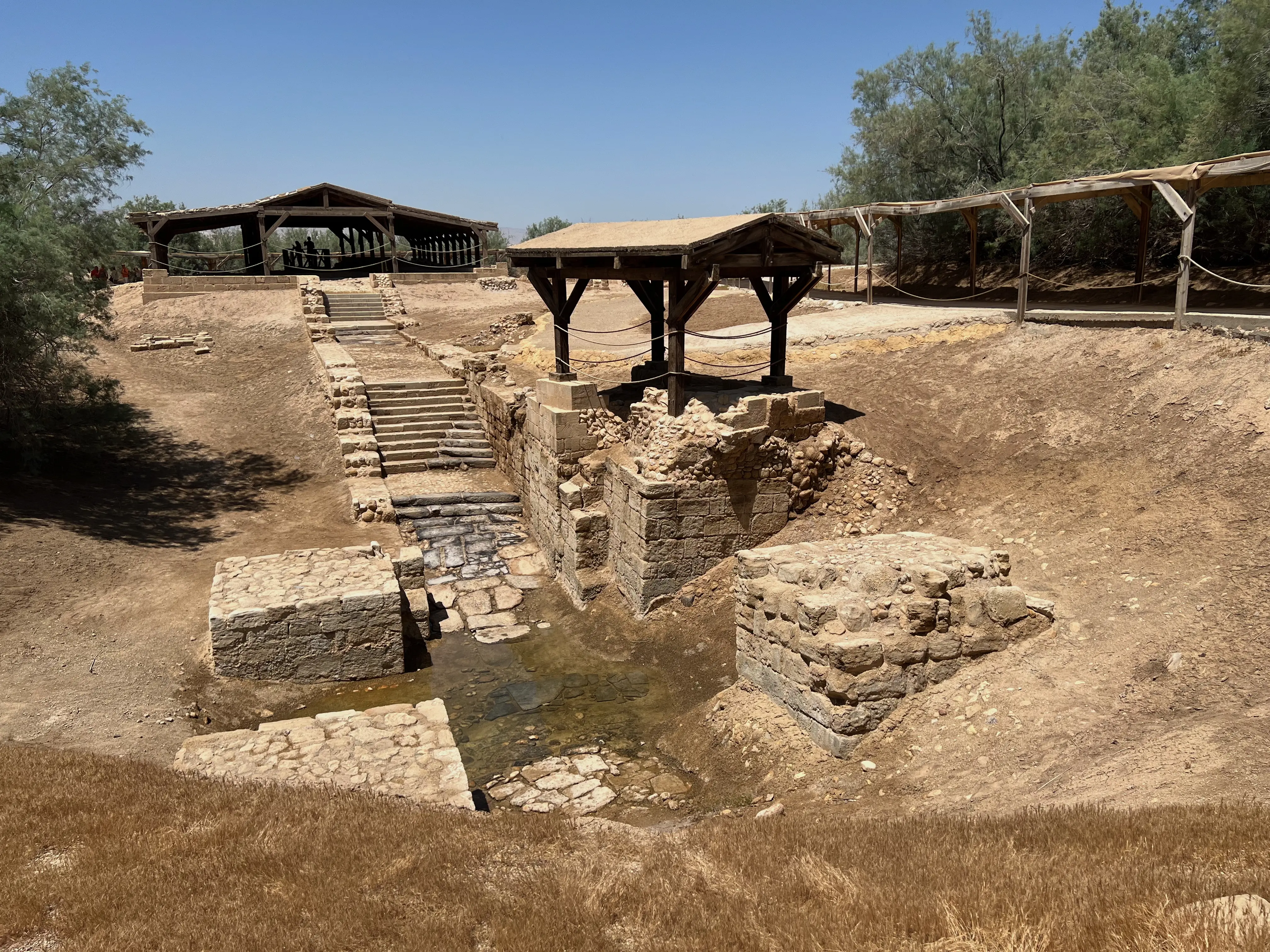
Our trip finished back in Amman at the Landmark hotel, where it had all started. We popped to the downtown area for one last bit of shopping then all went out as a group to a rooftop bar for some food and drinks overlooking the city.
Huge thanks to Ayman from G Adventures for taking us on this trip; he gave us so much information about the places we visited and Jordan as a whole, and made the trip a very memorable one. We also had great company on our group: Clive, Rosemary, Gordon, Vicki and Stefan - thanks for such an enjoyable week!
To quote Ayman:
Oh my god! This is so cool!